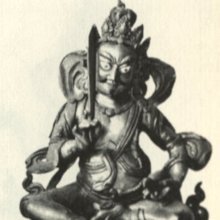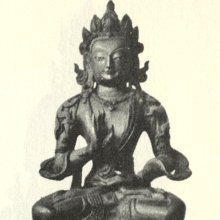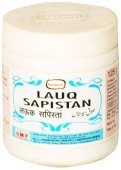Cu: 5 definitions
Introduction:
Cu means something in Hinduism, Sanskrit, Jainism, Prakrit, biology, Tamil. If you want to know the exact meaning, history, etymology or English translation of this term then check out the descriptions on this page. Add your comment or reference to a book if you want to contribute to this summary article.
Alternative spellings of this word include Chu.
Images (photo gallery)
(+363 more images available)
In Hinduism
Vyakarana (Sanskrit grammar)
Source: Wikisource: A dictionary of Sanskrit grammarCu (चु).—The group of palatal consonants viz. च्,छ्,ज्,झ् (c, ch, j, jh) and ञ् (ñ); cf चुट् (cuṭ) P. I. 3. 7, चोः कुः (coḥ kuḥ) VIII. 2. 30, कुहोश्चुः (kuhoścuḥ) VII. 4 62.

Vyakarana (व्याकरण, vyākaraṇa) refers to Sanskrit grammar and represents one of the six additional sciences (vedanga) to be studied along with the Vedas. Vyakarana concerns itself with the rules of Sanskrit grammar and linguistic analysis in order to establish the correct context of words and sentences.
Biology (plants and animals)
Source: Google Books: CRC World Dictionary (Regional names)Cu in Mexico is the name of a plant defined with Zea mays in various botanical sources. This page contains potential references in Ayurveda, modern medicine, and other folk traditions or local practices It has the synonym Zea mays var. pennsylvanica Bonaf. (among others).
Example references for further research on medicinal uses or toxicity (see latin names for full list):
· Enumeratio Stirpium Transsilvaniae (1816)
· Species Plantarum (1753)
· A Manual of Botany for the Northern States (1818)
· The Illustrated Dictionary of Gardening … (1887)
· Cyclopedia of American Horticulture (2006)
· Landwirthschaftliche Flora (1866)
If you are looking for specific details regarding Cu, for example side effects, diet and recipes, extract dosage, pregnancy safety, chemical composition, health benefits, have a look at these references.

This sections includes definitions from the five kingdoms of living things: Animals, Plants, Fungi, Protists and Monera. It will include both the official binomial nomenclature (scientific names usually in Latin) as well as regional spellings and variants.
Languages of India and abroad
Prakrit-English dictionary
Source: DDSA: Paia-sadda-mahannavo; a comprehensive Prakrit Hindi dictionaryCu (चु) in the Prakrit language is related to the Sanskrit word: Cyu.
Prakrit is an ancient language closely associated with both Pali and Sanskrit. Jain literature is often composed in this language or sub-dialects, such as the Agamas and their commentaries which are written in Ardhamagadhi and Maharashtri Prakrit. The earliest extant texts can be dated to as early as the 4th century BCE although core portions might be older.
Kannada-English dictionary
Source: Alar: Kannada-English corpusCū (ಚೂ):—[noun] an indeclinable used to urge a dog to bark at or fall upon.
Kannada is a Dravidian language (as opposed to the Indo-European language family) mainly spoken in the southwestern region of India.
Tamil dictionary
Source: DDSA: University of Madras: Tamil LexiconCu (சு) . The compound of ச் [c] and உ. [u.]
--- OR ---
Cu (சு) particle < su. Prefix to Sanskrit words signifying goodness, auspiciousness, as சுகுணம் [sugunam], opposed to tur; நண்மை, மங்கலம் முதலிய பொருள் பெற்று வடமொழிப்பெயர்கட்கு முன்வரும் சொல். [nanmai, mangalam muthaliya porul perru vadamozhippeyarkadku munvarum sol.]
--- OR ---
Cū (சூ) The compound of ச் [c] and ஊ. [u.]
--- OR ---
Cū (சூ) noun < சூ [su] onom.
1. Sound uttered in setting dogs on; நாயை ஏவும் ஒலிக்குறிப்பு. [nayai evum olikkurippu.]
2. Sound uttered to express disgust or aversion; வெறுப்பு முதலியவற்றை உணர்த்தும் ஒலிக்குறிப்பு. [veruppu muthaliyavarrai unarthum olikkurippu.]
3. A kind of home-made firework encased in cloth; பனங்கதிர் முதலியவற்றைக் கருக்கிப் பொடித்துத் துணியிற்கட்டி யமைக்கும் வாணவகை. கார்த்திகையிற் சூவிடுதல் வழக்கம். [panangathir muthaliyavarraig karukkip podithuth thuniyirkatti yamaikkum vanavagai. karthigaiyir suviduthal vazhakkam.] Local usage
4. A kind of torch; சுளுந்து. [sulunthu.] Nāñ.
Tamil is an ancient language of India from the Dravidian family spoken by roughly 250 million people mainly in southern India and Sri Lanka.
See also (Relevant definitions)
Starts with (+3038): Caupaini, Caura, Cibuku, Cu cao xi feng qin, Cu chi, Cu dau, Cu day san, Cu hua pu tao, Cu hui qiu hai tang, Cu jiang cao, Cu jing bei mu, Cu jing hong jing tian, Cu leng ai ze qin, Cu li, Cu liu guo, Cu mao ci guo teng, Cu san, Cu san dai, Cu sang, Cu ye rong.
Ends with (+1580): Accakeccu, Accimugulcu, Accu, Accumeccu, Acivakkacu, Acu, Acukucu, Acupecu, Adacu, Adagoccu, Adarcu, Adaricu, Adavigiccu, Adavigircu, Adavikiccu, Addagicu, Addahaccu, Addamcu, Adicu, Adigaccu.
Full-text (+4957): Sumana, Chu, Shu, Sugata, Sunaya, Sudiva, Subhiksha, Subhata, Sumanohara, Supura, Sukundaka, Sutardana, Sulabha, Sucitraka, Sudushcara, Susaravat, Susima, Supralambha, Subrahmanya, Subuddhi.
Relevant text
One of your search terms exceeds the minimun character amount per search term. This amount currently equals 2.
No search results for Cu, Cū, Su, Chu, Soo; (plurals include: Chus, Soos) in any book or story.
Related products
(+13 more products available)











